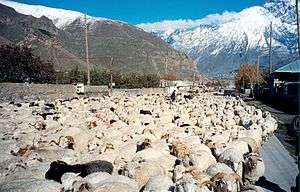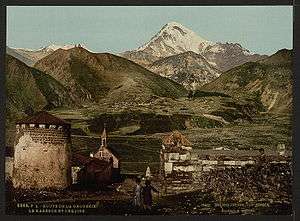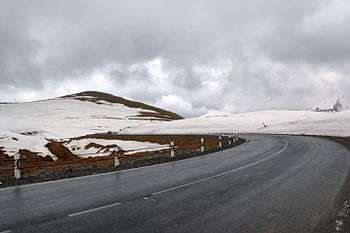Georgian Military Road
Coordinates: 42°30′15″N 44°27′14″E / 42.5042°N 44.4538°E


The Georgian Military Road (Georgian: საქართველოს სამხედრო გზა [sakartvelos samkhedro gza], Russian: Военно-Грузинская дорога [Voyenno-Gruzinskaya doroga], Ossetian: Арвыкомы фæндаг [Arvykomy fændag]) is the historic name for a major route through the Caucasus from Georgia to Russia. Alternative routes across the mountains include the Ossetian Military Road and the Transkam.
Route

The Georgian Military Road (ca. 212 kilometres long) runs between Tbilisi (Georgia) and Vladikavkaz (Russia) and follows the traditional route used by invaders and traders throughout the ages. From Vladikavkaz, the road stretches southwards up the valley of the Terek before passing through the Darial Gorge (which marks the border between Russia and Georgia). It then passes Mount Kazbek and Gergeti Trinity Church before heading south-west through the Georgian region of Khevi to the Jvari Pass, where it reaches its maximum altitude of 2,379 meters (7,815 feet) (42°30′15″N 44°27′14″E / 42.5042°N 44.4538°E). Not long after the pass the road passes the Russia–Georgia Friendship Monument, a large concrete monument built in 1983 to commemorate relations between the two countries and the bicentennial of the Treaty of Georgievsk. The road then turns south-eastwards, following the Tetri Aragvi River through Mtiuleti down to the town of Pasanauri, before heading due south. It then passes below the walls of the medieval fortress of Ananuri before cutting across the wide floodplain of the Tetri Aragvi down to a point just north of Georgia's historic capital, Mtskheta, where it merges into Georgia's main East-West highway (the E60). In this guise, the Georgian Military Road technically continues along the right bank of the Kura (Mtkvari) River before reaching nearby Tbilisi.[1]
The 1914 edition of Baedeker's Russia describes the Georgian Military Road as 'one of the most beautiful mountain roads in the world', and mentions the fact that, as early as its date of publication, 'motor omnibuses of the Société française des transports automobiles du Caucase ply regularly from April 15 to Oct. 15th, [accomplishing] the journey in 10 hrs.'[2]
History
It was known since antiquity (it was mentioned by Strabo in his Geographica and by Pliny). The route was first used by Russian troops in 1769. Pavel Potemkin sent 800 men to improve the road so that by October 1783 he was able to drive to Tiflis in a carriage drawn by 8 horses. The Georgian Military Road in its present form was begun by the Russian military in 1799, after the Georgians by the Treaty of Georgievsk, abjured from century long Persian suzerainty. Russian control of the Georgian Military Highway in the center divided the Caucasian War into the Russo-Circassian War in the west and the Murid War in the east.
After the Kingdom of Georgia was officially annexed by the Russian Empire in 1801, Tsar Alexander I ordered General Aleksey Petrovich Yermolov, commander-in-chief of Russian forces in the Caucasus to improve the surfacing of the road to facilitate troop movement and communications. When Yermolov announced the completion of work in 1817, the highway was heralded as the “Russian Simplon”. However, work continued until 1863. By this stage it had cost £4,000,000 (a staggering sum in the 1860s) but according to Bryce[3] in 1876 was of a high quality with two or three lanes and "iron bridges over the torrents", something he considered astonishing given that within Russia proper at this time decent roads were virtually non-existent.
The Georgian Military Road played an important role in the economic development of Transcaucasia and in the Russian-Circassian War.
The Georgian Military Road today
The importance of the Georgian Military Road as a through route was diminished in recent years, primarily due to delays at the border crossing between Russia and Georgia, natural disasters such as landslides,[4] and the outright closure of the border crossing by Russia in 2006.
Since 2013, however, when Russia finally agreed to re-open its side of the border as a result of Armenian demands, the road has once again become an important transport artery, mainly for trailer lorries linking Armenia and Russia.[5]
Various restrictions, however, remained (and still remain) in place, particularly for Georgian citizens, but by 2013 a representative of the Russian side of the border could tell the Interfax news agency that around 3 million people had passed through the Lars checkpoint.[6]
Currently (2015), the Georgian end of the Road is frequently clogged with lorries, apparently due to the length of time needed for vehicles transiting Georgia to be admitted into Russia.[7][8]
See also
References
- Rosen, Roger. Georgia: A Sovereign Country of the Caucasus. Odyssey Publications: Hong Kong, 1999. ISBN 962-217-748-4
- ↑ The Times Atlas of the World, 13th ed. (2011)
- ↑ Online copy of Baedeker's Russia (1914)
- ↑ Lord James Bryce, TransCaucasia and Ararat (London 1877), page 116
- ↑ "One Dead, Several Missing in Dariali Landslide", Civil Georgia, 18 May 2014
- ↑ "Russia and Georgia Expand Their Only Border Crossing Point", Jamestown Foundation, Eurasia Daily Monitor, 10(163), 16 September 2013
- ↑ "Russia-Georgia border crossing will be open 24 hours", DFWatch, 14 January 2014
- ↑ "Kilometer-long traffic jams at Upper Lars checkpoint", Vestnik Kavkaza, 28 June 2015
- ↑ "Armenia expeditor: Armenia should send emissary to Russia over traffic jam in Lars", News.am, 2 September 2015
External links
- Article on the Georgian Military Highway in Hidden Europe Mitchell, Laurence (2006) The High Road to the Caucasus: Exploring the Georgian Military Highway. Hidden Europe, 9, pp. 2–7 (July 2006) - in English.
- Article on the Georgian Military Highway in La Carretera Militar Georgiana - in Spanish.